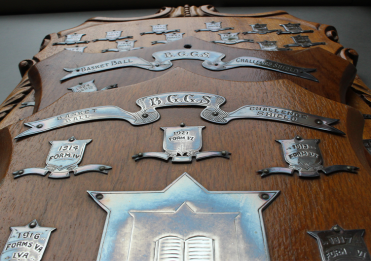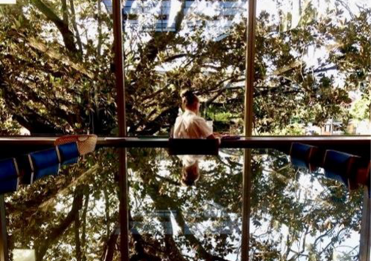After stepping across the 2000 Dream it, Dare it, Do it mosaic and through the imposing, sturdy front door of the Main Building, its original plans and framed front door keys are the first significant archival records, and indeed art works, that catch the eye.

The Gailey Plans

Front door keys
In 1875, when Brisbane Girls Grammar School first opened its doors as a place of learning for young women, its first home was a two-storey house on 428 George Street, welcoming 40 foundation students. The School quickly outgrew these premises, and classes moved to the corner of Lilley Street and Wickham Terrace. By 1882, plans were underway for the girls’ school to operate separately from Brisbane Grammar School. It was time for Brisbane Girls Grammar School to have its own permanent home, worthy of the aspirations of educating young women.
To this end, in 1882, the Board of Trustees applied for three acres of ground adjoining Brisbane Grammar and received two acres, two roods, and nine perches (Brisbane Grammar School Trustees Minutes, 28 April 1882). This land provided a commanding site with expansive views from the hill. Prominent architect, Richard Gailey, and his firm won the competition to design a two-storey building that would be both classrooms and home to some 90 students. Henry Holmes was contracted to build it for 6000 pounds. The government-approved plans were signed by Gailey on 9 February 1883.
Gailey had emigrated to Australia from Northern Ireland, in 1864, choosing to reside in Queensland. He came at an opportune moment when the colony of Queensland was experiencing a building boom. Gailey went on to design many iconic Brisbane landmarks that remain today as testament to his design skills and understanding of the environment of early colonial Brisbane. Examples of his prolific work can be seen in buildings such as the Regatta Hotel (1886), Moorlands (1892), and the Baptist Tabernacle (1889) in Spring Hill. Richard Gailey’s two daughters, Eva (1890) and Corinth (1900) were both to benefit from their father’s talent as students at Girls Grammar.
Gailey created a building in the late Victorian style that faced Gregory Terrace confidently. With its elegant arched windows and wide verandas—that were a nod to the subtropical climate—its architecture has ensured the School’s mark as a building of architectural and heritage significance in this precinct.

1884, Main Building
The first level would be designated classrooms, while the second would provide dormitory accommodation for the students, and rooms for the Head Mistress and some staff. The Foundation Stone was laid in 1883 by Sir Charles Lilley, and the School moved into the new building in 1884 under the guidance of Principal, Miss Sophia Beanland.

1883 Gailey Plans
Gailey’s plans and specifications are kept in the School Archive. The specifications are handwritten folio sheets, encapsulated in protective Mylar envelopes and contained within a bound volume and slip case. These are precious records, but the hand-drawn plans have been copied and framed so that the Girls Grammar community can fully appreciate the skilful and beautiful work. They are hung in pride of place in the foyer of Gailey’s building.
From an article in the Brisbane Courier, we can surmise that this first building for Brisbane Girls Grammar School was not fully completed when it was first occupied because, within a year, these original extensive plans again provided the template for what was termed a ‘large addition’ to the first building works.

1887 the iconic Brisbane Girls Grammar School Main Building
Recorded in The Queenslander on 1 January 1887: ‘When completed, the additions will consist of two stories of uniform design to the original. On the ground floor are two entrances, one at the side and the other at the rear. The side entrance is intended for the day scholars, on the right of which is a large cloakroom, fitted with hat and cloak-pegs, and boot racks, and wash basins. In the centre is a large hall, 39 ft x 32 ft, which runs the full length of the building, and is lighted by a large lantern at the top.’

1999 the first-floor gallery
The report continued: ‘On the first-floor level is a gallery, 5 ft wide, all round, to be used as a picture and art gallery. The hall (now the Annie Mackay Room) is to be used for drill and calisthenics, and general purposes. The dining room is a spacious apartment, 42 ft x 24 ft, lighted by bright windows, and connected to common room, 24 ft x 24 ft, by large folding doors. There are also four music rooms, a large kitchen, scullery, pantry, and serving room. On the first floor is a dormitory for 20 girls on the cubicle system, adjoining is the lavatory, provided with five baths, and a sufficient number of basins. On the left wing is a classroom, matron’s room, three music rooms, sick room, linen room, and four servants’ rooms’ (The Queenslander, 1 January 1887 p27).
Thus, Main Building was finally complete with a suite of three rooms for the Head Mistress.

1910 The School on Gregory Terrace with eastern tennis court

1920-1930 Entrance Hall
Gailey’s building has had many facelifts across the years. These renovations were created by: modernisation (including electricity in 1923); maintenance; catastrophic weather events (the 1985 hailstorm which destroyed the roof); and the demands and growth of a modern twentieth and twenty-first century school (for example, 1989-90, 1998, 2000, 2016). However, the exterior integrity and functionality of the design was ultimately restored and celebrated.

1890, Main Building
The earliest extant photograph of the building, from 1890—in black and white, of course—gives a sense of the walls painted a pale colour, possibly white, with dark guttering and dark shutters framing the windows. The building was enhanced by lovely wrought iron balustrades on the verandas, and inside, the use of deep oak timber stair railings and balustrades containing a mezzanine gallery, along with marble fireplaces, gave a warmth and beauty to the design. In the 1890 photo, one or two trees appear to grow in the front and by that time there is the famous white picket fence. At that moment in its history, there is no hint of a manicured or curated landscape.

2013, wrought iron balustrade
The Main Building may have been the heart of the School, but the front door was strictly forbidden to students; the back and side entrances were their portals. Patricia Marie Stephens (Smith, 1949) recalled Miss Lilley farewelled her VI Form class for the last time through the front door—so times were changing—and the building and its main entrance were opening to a growing school population, and more flexible spaces and protocols.

1890, students (taken on the front steps—an entrance they would not normally have access to)
But what of the aforementioned ‘sturdy front door’ guarding the Main Building’s exclusive entrance? In 1884, there were two metal keys used to lock Girls Grammar’s front door. These keys have their own intriguing story.

1884, front door keys to the Gailey Building
In the mid-1980s, the School Bursar from 1970 to 1985, Mr John Willmott, found the keys in an office drawer, and felt they were no longer useful as the lock had been replaced, and thus the keys were destined for the rubbish. Happily, they were rescued by a long-term member of the School accounts’ team, Ms Toby Humble, who took the keys home. In 2013, when downsizing, Ms Humble found the brass keys again and felt they needed to be returned to the School. They were given to English staff member, Ms Helen Geraghty, who returned them to the Archives and their rightful home (Toby Humble, 18 July 2023).

The front door of the Main Building
The keys, now slightly tarnished, are dull metal and measure 120 mm in length and the bow is 35 mm. The keys were framed in 2016 in a shadow box with a plaque which reads ‘Keys to Girls Grammar, Brisbane—1884’.

Reginald Trebilco’s depiction of the 'sturdy front door' leading to the Main Building foyer
Since this iconic original building was completed, more than 25 images, paintings, prints, drawings, etchings, and even an Esther Beanland prize-winning multimedia depiction of the School are now valued elements of our Fine Arts Collection. Many of these images were created by students of their day or alumnae artists. Each image expresses the rich character and constancy of the building. While the environment may have changed, as it approaches its 140th anniversary, the building remains as a beautiful and significant testimony to the dedication of Richard Gailey and the builders who created an architectural monument. The Gailey plans and those impressive keys remind us that this building is not only a heritage showpiece but also symbols of Girls Grammar’s original aspirations, longevity, commitment to girls’ education, and belief in equal opportunity.
Mrs Lorraine Thornquist (Williams, 1967)
Manager, Fine Arts Collection
References
BGGS Annual Reports 1970 to 1986.
BGGS School Magazine 1985.
Brisbane Courier (Qld: 1864 – 1933), ‘Official Notification (From today’s Government Gazette)’ Saturday 9 September 1882, page 6.
Brisbane Courier “Grammar School Improvements” Saturday 25 December 1886, page 6.
Humble, Toby 18/07/23 email.
The Queenslander ‘Grammar School Improvements’ 1 January 1887 page 27.

1959, front gate and entrance

1883 Front and side elevations and longitudinal and transverse sections of Gailey Plans




